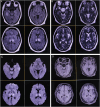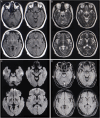An Intriguing Case of Expanded Dengue Syndrome With Co-existing Encephalitis, Pancreatitis, and Hepatitis: The Classic Thalamic "Double-Doughnut" Sign Revisited
- PMID: 38894998
- PMCID: PMC11181972
- DOI: 10.1177/19418744241230730
An Intriguing Case of Expanded Dengue Syndrome With Co-existing Encephalitis, Pancreatitis, and Hepatitis: The Classic Thalamic "Double-Doughnut" Sign Revisited
Abstract
Background: Dengue neuro-infection can present with symptoms ranging from mild to severe. Atypical presentations, such as expanded dengue syndrome, pose diagnostic and therapeutic challenges. Neuroimaging findings, particularly the "double-doughnut" sign on brain magnetic resonance imaging (MRI), have emerged as one of the most valuable aids in diagnosing complex cases of central nervous system infection by dengue virus.
Case presentation: We report the case of a 35-year-old female from rural West Bengal, India, with expanded dengue syndrome. The patient presented with fever, headaches, body aches, and sudden disorientation over minutes, which progressed to a coma. Neurological examination revealed profound unconsciousness and nuchal rigidity. Laboratory findings were consistent with dengue infection, including altered liver and pancreatic enzyme levels. The diagnosis was facilitated by identifying the "double-doughnut" sign on the brain MRI, which suggested dengue encephalitis. This finding and clinical and serological evidence guided the treatment strategy.
Discussion: The "double-doughnut" sign, though not exclusive to dengue encephalitis, proved crucial in this case, aiding in differentiating from other causes of encephalitis. Recognition of this sign can be pivotal in diagnosing expanded dengue syndrome, facilitating timely and appropriate intervention, and improving patient outcomes. This case also underscores the importance of considering dengue in the differential diagnosis of encephalitis, especially in endemic areas. Also, this case's excellent outcome (both clinically and radiologically) was noteworthy.
Keywords: encephalitis; expanded dengue syndrome; hepatitis; pancreatitis; pleural effusion; “double-doughnut” sign.
© The Author(s) 2024.
Conflict of interest statement
The author(s) declared no potential conflicts of interest with respect to the research, authorship, and/or publication of this article.
Figures


Similar articles
-
Signs and symptoms to determine if a patient presenting in primary care or hospital outpatient settings has COVID-19.Cochrane Database Syst Rev. 2022 May 20;5(5):CD013665. doi: 10.1002/14651858.CD013665.pub3. Cochrane Database Syst Rev. 2022. PMID: 35593186 Free PMC article.
-
Uncommon Non-MS Demyelinating Disorders of the Central Nervous System.Curr Neurol Neurosci Rep. 2025 Jul 1;25(1):45. doi: 10.1007/s11910-025-01432-8. Curr Neurol Neurosci Rep. 2025. PMID: 40591029 Review.
-
Severe dengue encephalitis showcasing the "double doughnut sign" on MRI: A case report.Radiol Case Rep. 2025 Jul 5;20(9):4820-4824. doi: 10.1016/j.radcr.2025.06.043. eCollection 2025 Sep. Radiol Case Rep. 2025. PMID: 40686795 Free PMC article.
-
Dengue encephalitis: what's new?Curr Opin Infect Dis. 2025 Jul 22. doi: 10.1097/QCO.0000000000001128. Online ahead of print. Curr Opin Infect Dis. 2025. PMID: 40747708
-
Magnetic resonance perfusion for differentiating low-grade from high-grade gliomas at first presentation.Cochrane Database Syst Rev. 2018 Jan 22;1(1):CD011551. doi: 10.1002/14651858.CD011551.pub2. Cochrane Database Syst Rev. 2018. PMID: 29357120 Free PMC article.
References
-
- Majumdar R, Jana CK, Ghosh S, Biswas U. Clinical spectrum of dengue fever in a tertiary care centre with particular reference to atypical presentation in the 2012 outbreak in Kolkata. J Indian Med Assoc. 2012;110(12):904-906. - PubMed
-
- Kadam DB, Salvi S, Chandanwale A. Expanded dengue. J Assoc Physicians India. 2016;64:59-63. - PubMed
-
- World Health Organization Comprehensive guidelines for prevention and treatment of dengue and dengue hemorrhagic fever. New Delhi: WHO, SEARO; revised and expanded edition. Available at: https://www.aedescost.eu/sites/default/files/2023-01/WHO_SEA-Comprehensi...
Publication types
Grants and funding
LinkOut - more resources
Full Text Sources
